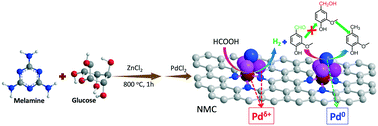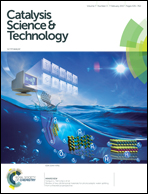Transfer hydrogenation of bio-fuel with formic acid over biomass-derived N-doped carbon supported acid-resistant Pd catalyst†
Abstract
Nitrogen-enriched highly mesoporous carbons (NMCs) are synthesized via the one-pot carbonization of biomass-derived glucose and harmless melamine with ZnCl2 as the porogen agent and catalyst. NMC contains an N content of 15.4 wt% and specific surface area of 1017 m2 g−1 with the mesopore volume proportion of 92.1%. Owing to its rich N species and high mesoporosity, NMC can be adapted as a proper support for the fabrication of well-dispersed Pd catalysts for the transfer hydrogenation of vanillin in the water phase with formic acid (FA) as the hydrogen donor. For example, Pd/NMC exhibits 2.9 times higher activity in comparison to nitrogen-free catalysts, and affords 100% vanillin conversion with 2-methoxy-4-methylphenol (MMP) as the sole product. The Pd/NMC catalyst demonstrates enhanced acid-resistance in acid media and adsorption of substrates. It is found that the electron-deficient Pd (Pdδ+) percentage is affected by the N species, and the strong Pd–N interaction generates the co-existence of Pdδ+ and metallic Pd (Pd0), which results in Pd/NMC as a novel bifunctional nanocatalyst for both FA dehydrogenation and vanillin hydrogenation.

- This article is part of the themed collection: 2017 Catalysis Science & Technology HOT Articles


 Please wait while we load your content...
Please wait while we load your content...